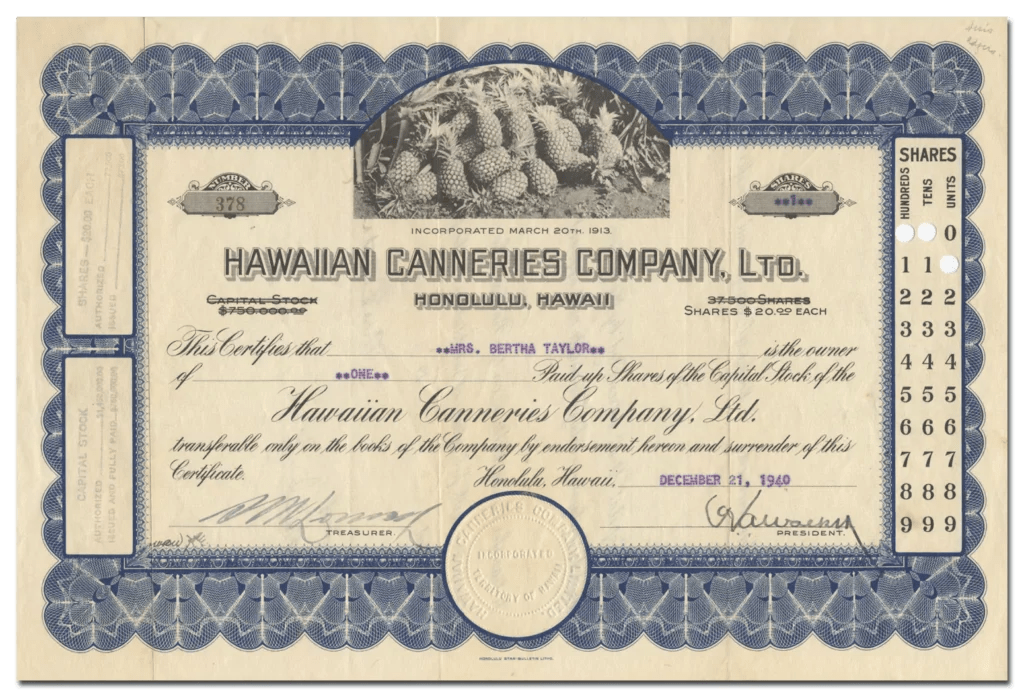Dan Charles Derby was born in Santa Fe, Kansas on February 18, 1890, the son of Spurzheim and Mary Catherine ‘Mollie’ (Erickson) Derby. He was educated in grammar schools and business college.
He had three years’ experience as an agriculturist with the Natomas Company of California in their fruit orchards near Sacramento. (Nellist)
Natomas planted several experimental farms, including a grove of Blue Gum Eucalyptus and an Orange Grove. Land to the east of Natomas was leased as experimental orchards, the land west was used for Wheat. (PacificNG)
During this time, he was made foreman. The manager there was assigned by the Chicago Canning Company, Libby, McNeill & Libby (Libby’s), to grow pineapple in Hawaii. He took only two of his men, Dan C Derby, the grower, and Arthur F Stubenberg, a natural mechanic. (Merilyn K Derby, daughter).
In June 1917, Derby came to the Islands to manage Libby’s pineapple plantation in Pupukea, on O‘ahu’s North Shore. (Wife Waleska K Derby’s oral history)
For the next 38-years Derby worked with Libby’s; at his retirement he served as Libby’s General Plantation Manager. (Adv, Feb 28, 1955) (In 1920, Dan Derby married Waialua School teacher Waleska Kerl; they had two daughters, Jeanne, born in 1921, and Merilyn born in 1925, and one son, Dan Jr. born in 1929.)
Libby’s, one of the world’s leading producers of canned foods, was created in 1868 when Archibald McNeill and brothers Arthur and Charles Libby began selling beef packed in brine.
In the early 1900s, it established a pineapple canning subsidiary in Hawaiʻi and began to advertise its canned produce using the ‘Libby’s brand name. In 1912 Libby, McNeill and Libby bought half of the stock of Hawaiian Cannery Co.
Unlike the other bigger pineapple producers, Libby’s did not start in Central Oʻahu; by 1911, Libby’s gained control of land in Kāne‘ohe and built the first large-scale cannery at Kahalu‘u. This sizable cannery, together with the surrounding old style plantation-type housing units, became known as “Libbyville.”
During most of the period when this cannery was in operation, the canned pineapple was transported to Honolulu by sampan from a pier just off the end of the peninsula near Libbyville.
Growing and canning pineapples became a major industry in the area for a period of 15 years (to 1925.) At its peak, 2,500 acres were under pineapple cultivation on Windward O‘ahu, and of this a large percentage was in the Kāne‘ohe Bay region.
The change in landscape to the Windward side by 1914 is reflected in the following sentences: “At last we reached the foot of the Pali… Joe and I looked over the surrounding hills …”
“… but looked in vain for the great areas of guava through which but a few months ago we had fought and cut our way. As far as the eye could reach pineapple plantations had taken the place of the forest of wild guava.” (Cultural Surveys)
Later, Libby’s expanded to the Leeward side, in Wahiawa and Kalihi, and then on Maui and Molokai. (Hawkins) By the 1930s, more than 12-million cases of pineapple were being produced in Hawai‘i every year; Libby’s accounted for 23 percent of that.
“A pioneer for Libby, Mr Derby opened up the Libby holdings on the Big Island in 1921, on Molokai in 1923 and on Maui in 1926. The next year he was made general manager over all Libby’s plantations in the Hawaiian Islands, and has aided the growth and development of pineapple for his company”. (Adv, Feb 28, 1955)
Libby’s need to ship fruit from the growing area on Molokai to pineapple processing on Oʻahu created an opportunity for the Young brothers.
Libby’s built a wharf at Kolo, just below Maunaloa. Kolo had a shallow channel, and the Inter-Island Steam Navigation ships couldn’t get in.
The brothers made a special tender and with their first wooden barges, YB-1 and YB-2, Young Brothers carried pineapple from Kolo Wharf to Libby’s O‘ahu cannery. “That’s how [Young Brothers] started the freight.” (Jack Young Jr)
The end of the pineapple era began in 1972 when Libby’s sold to Dole Corp and was finalized three years later when Dole closed its Maunaloa facility. (West Molokai Association)
“With the growth of the pineapple industry in the Wahiawa area, my grandfather told me that he was concerned about the cultural significance of Kukaniloko.”
“There was another plantation that abutted the rocks and boulders who wanted them removed for planting, however, he protested and supported efforts to preserve the sacred and historic site in the early 1920s.“ (granddaughter Dana Ritchie Fujikake)
“He was a modest kindly person, never scolding us as children, but instead sharing a parable to teach us the lesson we were to learn.” “If a man is treated with dignity, he will behave with dignity” was one of his sayings. (granddaughter Dana Ritchie Fujikake)
“The industry, as well as Libby, McNeill and Libby, loses one of its foremost men, Mr Derby has played an important part in the development of pineapple in Hawaii.” (Adv, Feb 28, 1955)
Dan Derby died January 22, 1975. “The Derby crypt at Hawaiian Memorial Park overlooks his fields.” “God’s Own Nature,” he would say of his beloved Ko‘olau vista. (granddaughter Dana Ritchie Fujikake)
































